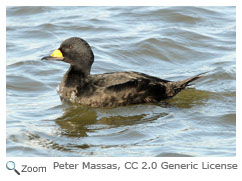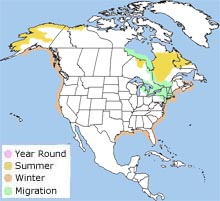Black Scoter - Melanitta americana |
|||||||||||
Description
Range |
HabitatThe black scoter breeds in lakes and ponds in boreal forests It winters in the ocean and in saltwater bays. DietThe black scoter is a medium-sized diving duck. When it is at sea, it dives for crustaceans, mollusks, small fish, and marine worms. When it is in its breeding range, it eats aquatic insects, mollusks, crustaceans, and aquatic insects and plants. Life Cycle
The female black scoter lays 5-10 eggs in a nest made in a hollow in tundra grass. The nest is lined with grass and down and made near the water. The chicks hatch in about 27-31 days. They leave the nest shortly after hatching and can feed themselves immediately. They stay with their mother for about three weeks. Behavior
Black scoters are the most vocal of all the scoter species. The male black scoter makes a musical two note coor-loo whistling call. |
||||||||||
Audio Credit: xeno-canto.org Ian Cruickshank |
|||||||||||



 The black scoter breeds on freshwater tundra ponds in western Alaska and Labrador and Newfoundland in Canada. It winters on bays along the Pacific Coast, the Atlantic Coast, the Gulf Coast, and the Great Lakes.
The black scoter breeds on freshwater tundra ponds in western Alaska and Labrador and Newfoundland in Canada. It winters on bays along the Pacific Coast, the Atlantic Coast, the Gulf Coast, and the Great Lakes.